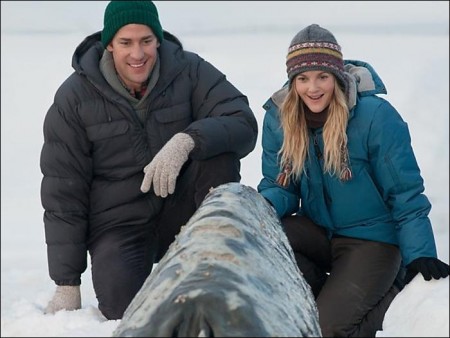Perhaps the biggest challenge for Big Miracle was tackled thousands of miles away in New Zealand during preproduction. Inside the Auckland workshops of Glasshammer Visual Effects, three important co-stars were being designed and built. Glasshammer was asked to meticulously create a trio of very valuable California gray whales the screenwriters had christened Fred, Wilma and Bamm-Bamm.
New Zealand-based special-effects wizards JUSTIN BUCKINGHAM and MIKE LATHAM were assigned to create the film’s central illusion: to ensure that the California gray whales came alive on screen. Buckingham’s company, Glasshammer, had created the lifelike whales for the 2002 blockbuster Whale Rider, work that caught the eye of the filmmakers.
“My company constructed the gray whales,” says Buckingham, “and Mike designed the animatronics, robotics and hydraulics. I had received a phone call about our availability to make these three whales, and I was quite excited from the beginning.”
Foremost in Kwapis’ mind was the whale makers’ ability to create lifelike animals. “We needed the whales to look perfectly real,” says the director, “and I wanted to give the actors something tangible to interact with. We studied archival footage of the trapped whales to understand how they moved. We didn’t want to anthropomorphize them, but we gave each one distinct markings so that over the course of the film viewers could distinguish them as characters. Gray whales have rough textures that give them a kind of gnarly beauty; I feel it makes them even more endearing.”
An additional requirement would be to build a whale pool that could realistically hold the puppets while allowing them to move freely and convincingly. “We built an ice-field set, complete with an underground water tank for the animatronic whales to inhabit,” adds Kwapis. “The animatronic whales were able to surface in any part of the pool, and in any order. It was a real engineering feat, and it worked extremely well.”
The whales would have a finished look that was as close as possible to the actual 1988 whales, complete with barnacles, scars and more. Shares Buckingham: “We looked at a lot of news footage of the actual event and studied the look and movement of the creatures. Once we worked out the scale, we started sculpting the heads.”
For two of the whales, Buckingham and Latham conceived of a movable platform that could be walked underwater and made it possible to move the interchangeable whale heads independently. The hydraulics were connected to a nearby control platform out of the camera’s field of vision. While Buckingham conceived of the realistic whale heads, Latham was busy creating their interior electronics. “We thought the biggest challenge was going to be how to design equipment that would not freeze or be affected by standing in water all day,” says Buckingham. “That informed me on what materials to make the heads from so that they would last over the entire shoot.”
Construction rolled along for four months, culminating in a Pacific Ocean cruise from New Zealand to Anchorage. “After we did water tests in New Zealand, we packed all three whales in containers and shipped our gear to Alaska,” says Latham. “We just hoped they would make the journey all in one piece, which they did. Once there, we prepared the whale hole on the ice field set and placed our equipment in the water for the first time. I must say, when the whales made their appearance, they were gorgeous.”
Alaska native John Pingayak, a whaler in his own life, felt the immediate connection to the whale puppets that aided his own performance. “When I saw those whales,” says Pingayak, “I felt comfortable for the first time in front of the camera. Fred, Wilma and Bamm-Bamm were amazingly lifelike.”
Seeing the whales for the first time excited the rest of the cast and crew, many of whom did not expect to see such close approximations. Shares Krasinski: “Once I saw the whales, I was hooked. They are so brilliantly created; they are like pieces of art. They became the heart and soul of the movie.”
“The only other similar experience I had was on E.T.,” adds Barrymore. “I was able to work with something that was tangible, something that looked like a real being that allowed me to have a chemistry and interaction that cannot be replaced. You are on the ice, touching these whales and there is nothing fake about it. I got so emotional because they looked so beautiful.”
When it came time to shoot the scene in which she swims with the animals, Barrymore donned scuba gear and submerged herself. On a drizzly day, she shot an underwater scene filmed in a seal tank at the Alaska SeaLife Center in nearby Seward. “I did not realize how cold that water would be,” recalls the actress. “When you enter 40-degree water, even in a scuba suit, it feels like knives hitting your head, like a brain freeze. But I wanted Ken to be able to seize that moment because it was important for the film. It breathes with a different energy when it is real.”
Related Link: Read the Full Production Notes for Big Miracle
Views: 558



